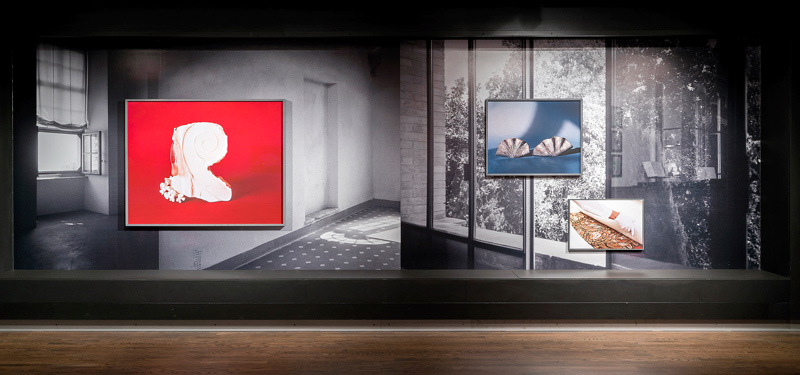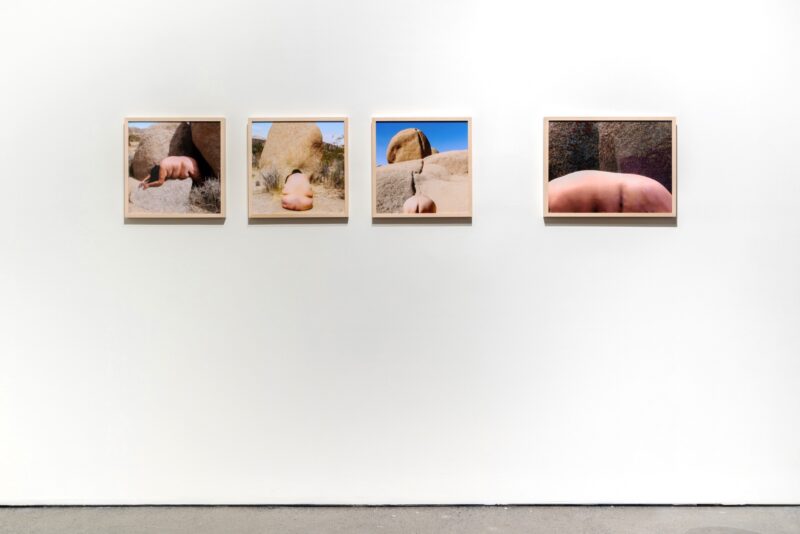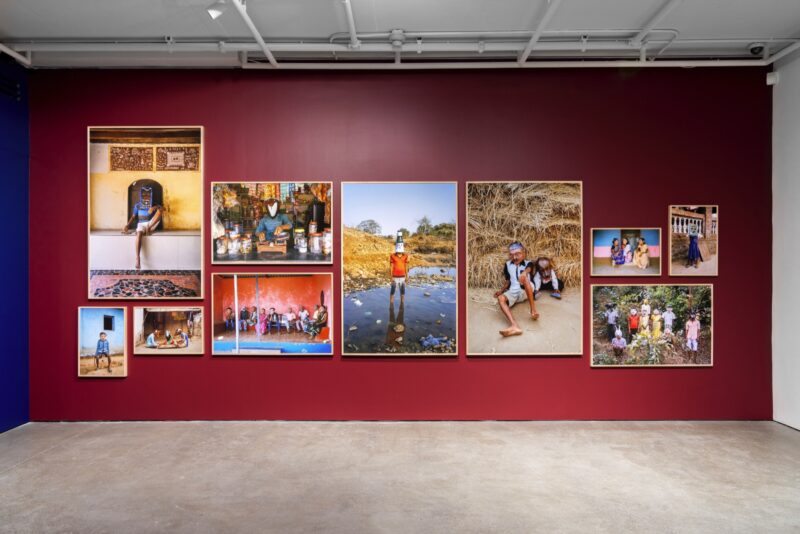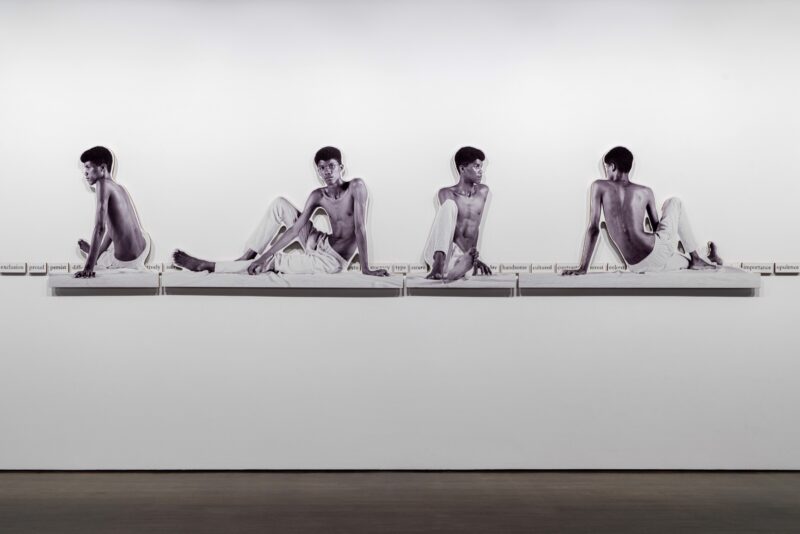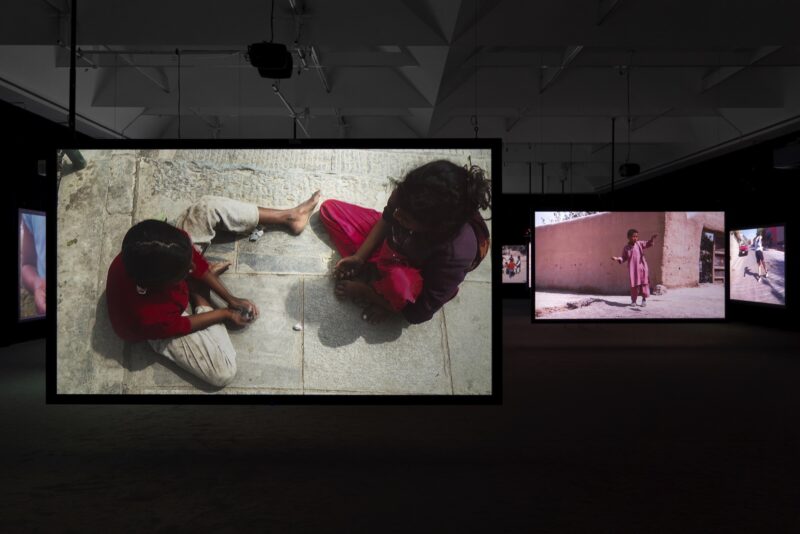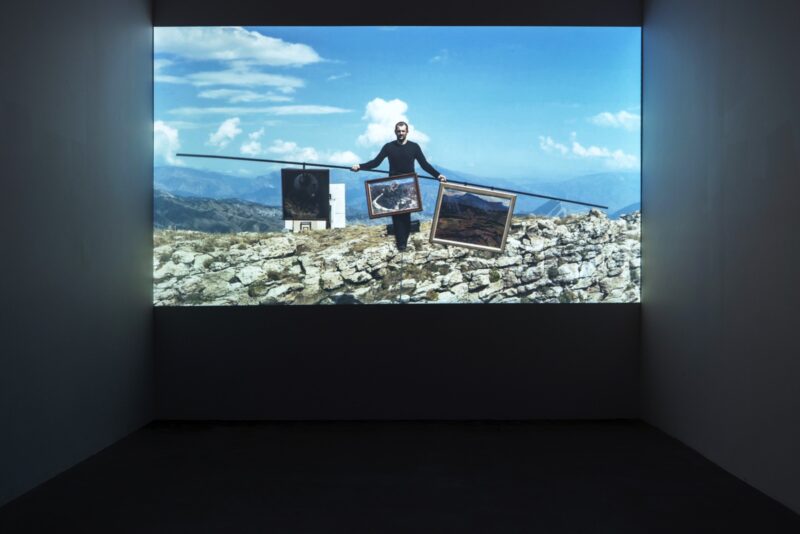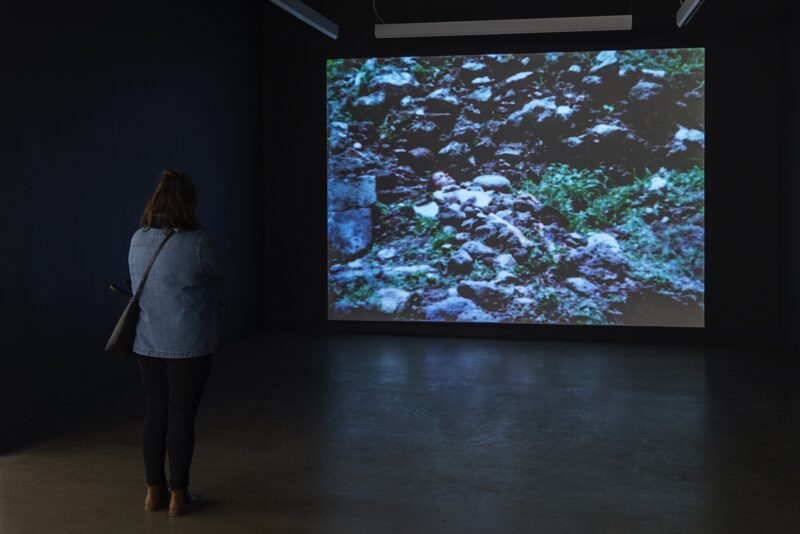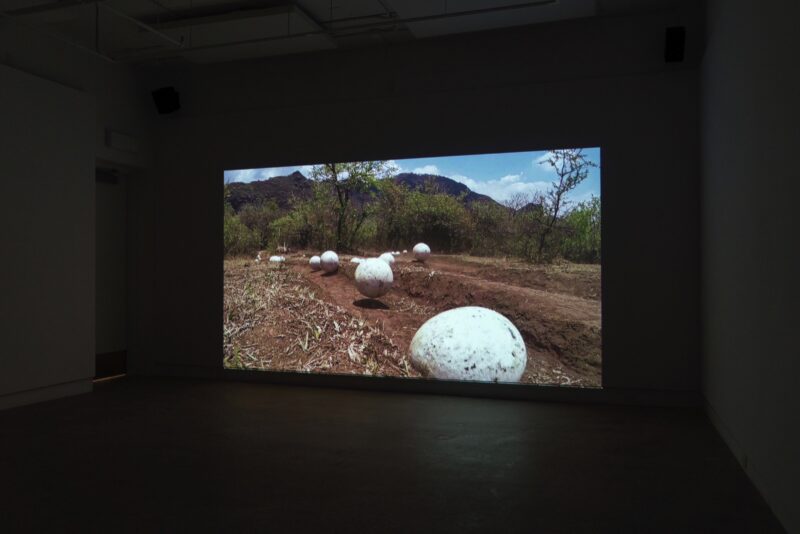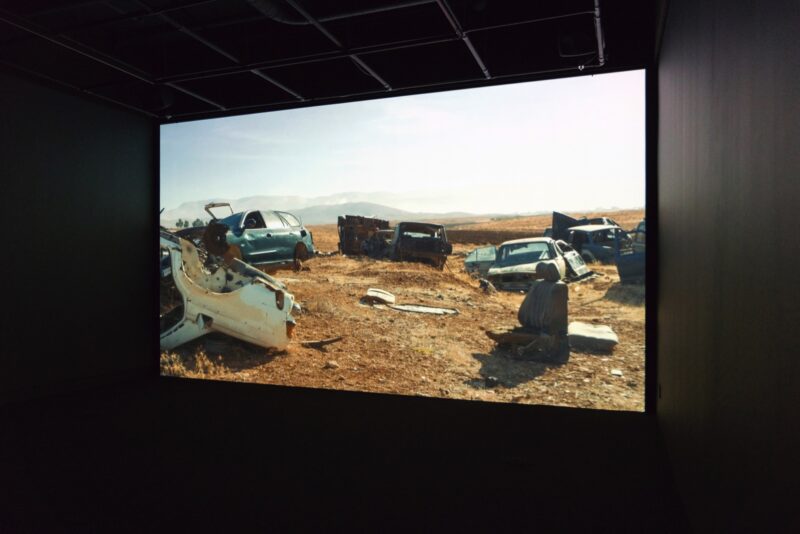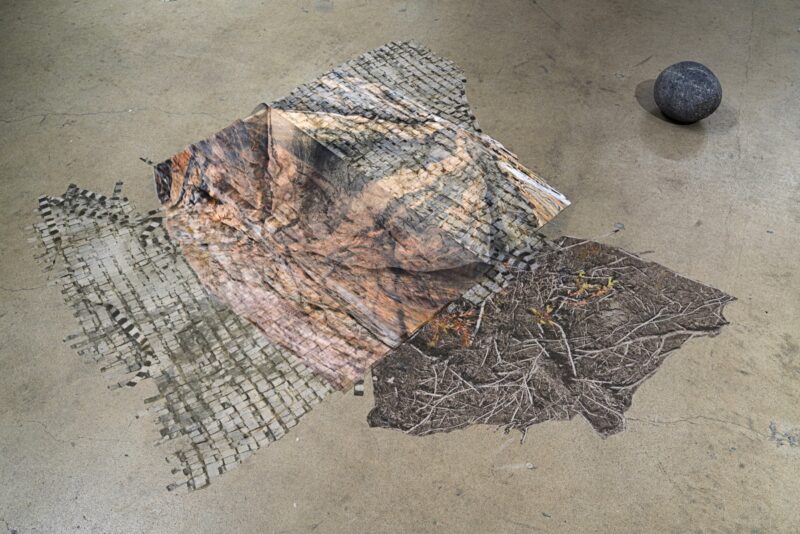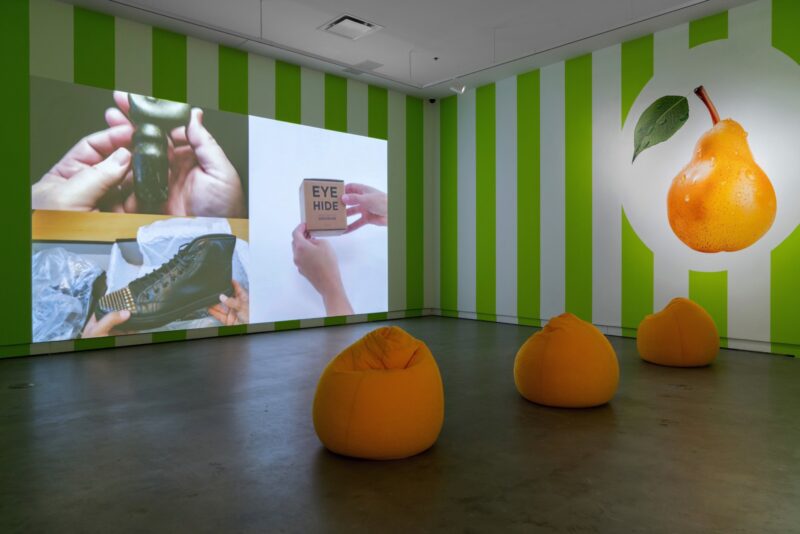[Summer 2020]
By Charles Guilbert
For the second edition of Momenta | Biennale de l’image1 (it had fourteen editions under its previous name, Le Mois de la photo), co-curators María Wills Londoño, Audrey Genois, and Maude Johnson chose an evocative and seemingly paradoxical title: The Life of Things. It was a title that might bring to mind philosophical currents such as speculative realism (also called object-oriented ontology), which challenges the anthropocentric definition of reality. Although certain virulent critics of this current of thought deem it not realism but idealism, numerous artists over the centuries have conjured the idea of a two-way relationship with things and the need for people to listen to them. Like any title, the one for this biennale thus opens a horizon of expectations for spectators, who obviously want to see how those four little words resonate in the works.
It is impossible here to provide an exhaustive review of Momenta, a huge and highly professional event: there were too many works presented (more than 150, by thirty-eight artists, in thirteen venues, plus an impressive catalogue)! Instead, I focus on the main angles of approach taken by the artists.
Erasure. Among the strongest works presented in the biennale were those in which the human figure is absent and the singular sensation of the autonomy of inanimate things shines through. Miguel Angel Ríos’s two videos2 create a tension between things and space that is open to various interpretations. In The Ghost of Modernity (Lixiviados) (2012), a translucent cube floats above a desolate area where randomly constructed houses seem to have fallen from the sky. This sort of glass house, utterly pure and not subject to the law of gravity, haunts a place strewn with garbage, highlighting the political and environmental violence manifested in things themselves. Piedras Blancas (2014) produces just as strong a poetic effect, but without special effects: we see and hear – the audio is remarkable! – thousands of white balls bouncing down a mountain, a surrealist horde noisily following a natural trajectory: furrows that we realize have been dug by rain run-off. Starting with the premise of a simple displacement of material (from water to concrete), Ríos troubles the material’s strength and “logic,” which are normally obscured. This work is interesting less for its metaphoric scope – which the curator and the artist highlight (one speaking of migration, the other of cocaine trafficking) – than for its unusual way of providing access to the presence of things.
The decision to include a 1987 classic by Fischli and Weiss in the biennale is interesting, although the tight space provided for its display was not ideal. Der Lauf der Dinge3 (which could be translated as “the flow of things”), a 16 mm film, presents a series of objects (tires, planks, ladder, candles, and so on) placed in a huge disused industrial space and set in motion by a chain reaction. Combustion, explosion, spillage, toppling – a broad repertoire of small causes and small effects are summoned to create surprising relationships among the objects. Here again, there is no human presence – except that behind the camera, which witnesses this mischievous cavalcade punctuated with suspense in a (false) sequence-shot. Although everything was carefully and artistically planned by the creators, the work emanates a feeling of magic and chance, reminding us that our world is the result of things in perpetual transformation.
In her elegant installation sourced from the McCord Museum collection, Celia Perrin Sidarous4 addresses another kind of motion: that of a secret magnetism among the objects revealed in her different “arrangements.” Although the title of the work is The Archivist (2019) and we see here and there a white-gloved hand, it is not subjectivity that is foregrounded but attention to the characteristics of objects and their quality of presence, both in their real form and in the photographs of them (in colour and black and white). The gallery itself may be perceived as an object, as Perrin Sidarous has adorned it here and there with art deco false columns and a pleated curtain (which itself is used as a support for the image of an object), and she has papered some walls with large photographs (of vast spaces pierced with windows). We feel like we are in a three-dimensional still life in which not only the objects themselves (vases, paperweights, earrings, flasks, and so on) echo each other but so do the shapes, colours, and textures of which they are made: folds, holes, hollows, lustre, and more. Following this visual rhetoric, we come into relation with what Perrin Sidarous calls “the thing quality of the thing.”
Consciousness of the space and accumulation of objects is also behind the installation by Hannah Doerksen,5 but this time spectators find themselves facing an ambiguity: should they look at these vases, disco lamps, mirrors, paper flowers, cigarette packages, and psycho-pop books for themselves or because they reveal the identity of an (absent) individual who can be divined as both despairing and sympathetic to refined kitsch? The title of the work, MAKING A RELIGION OUT OF ONE’S LONELINESS (2019), indicates that we are midway between the life of things and the things of life – between the mystery of inanimateness and the vagaries of the human heart.
Juxtaposition. Some works find equilibrium by strategies not of erasure but of juxtaposition. This is the case for Laura Aguilar, who, for the series Grounded6 (2006), photographed herself nude, sitting in an arid national park, turning her back to us and facing boulders whose colour and weight echo those of her own large Chicana body. In this meditative cohabitation, the properties of the human and the thing seem to be exchanged in a poignant ontological dialogue. Even as she claims a place for marginalized bodies, Aguilar awakens us to the “soul” of the landscape.
Kader Attia performs a similar tour de force in Open Your Eyes7 (2010), a double projection of a series of eighty fixed images juxtaposing colour photographs of objects most of which come from Africa (containers, masks, sculptures, and other things) and black-and-white photographs of the disfigured faces of Western soldiers of the First World War. The clear parallels established between these objects and these photographs (all taken from museum collections) are touching: a man missing an eye appears alongside a mask with a bit of an eye missing; a broken vase whose pieces stitched together appears alongside a man whose face is full of sutures. We are simultaneously revolted by this evidence of human barbarism and touched by the extraordinary solicitude devoted to the things. Here again, qualities are exchanged: the presence of objects highlights the materiality and fragility of the human body, and the presence of the wounded men allows us to feel the ordeals suffered by the objects. On this reflection on the relations between humans and things is superimposed a questioning about the relationships between the West and other parts of the world – something museums rarely think to address.
Fusion. Whereas the artists opting for strategies of erasure or juxtaposition highlight the life of things, those who present a fusion between body and things do not always succeed, in my opinion, as subjectivity – and identity-related questions – often seem to cannibalize the object.
The legendary Ana Mendieta avoided this pitfall in her two short films8 shot in super-8 more than forty years ago. Through performative acts, she brilliantly reminds us that no emancipation is possible without taking the force of things into account. In Alma, Silueta en Fuego (1975), we see a piece of white fabric, arranged in the silhouette of a body lying on the ground, consumed in fire; in Burial Pyramid (1974), we find a woman lying on the ground under a pile of stones from which she gradually frees herself. We sense here how much body and matter are connected.
Another type of communion is found in Jonathas de Andrade’s video O Peixe9 (2016), in which Brazilian fishermen hold against their nude torsos, in a sensual and ambiguous way, large fish that they have caught. In these body-to-body poses, the relations of force become disturbing. But are fish things? Animals, placed in a position of domination, are often considered such, as are marginalized human beings. This is what is called “thingification,” a concept central to the selection of many of the works in the biennale. These works have in common their critical gaze on the alienating process at the source of oppression of women and queers and of racism, colonialism, and neoliberalism. It was, among other things, by taking up the concept of thingification that the biennale achieved its central objective, according to the director, Audrey Genois: “Core to our mission is to make the public aware of the societal issues that we address through contemporary art.”10 If this statement makes one gnash one’s teeth a bit – is this not an instrumentalization of art? – it clarifies the choice to talk about both the life of things and the life of the thingified. But aren’t these two distinct intentions? The multiplication of paths, with a title containing words as polysemic as “life” and “things,” was to be foreseen.
In Gauri Gill’s photographic series Acts of Appearance (2015),11 in which she carefully frames scenes of life in India, the subjects are dressed up in animal masks, which, by their incongruous presence, portray daily life as a fiction. But it is not the life of these objects that is highlighted in these photographs; it is again that of humans.
Similarly, Francis Alÿs, in Children’s Games12 (1999–2017), underlines the universality of certain behaviours. Projected simultaneously on twenty screens, short videos show how, regardless of the political, economic, and social circumstances in which they find themselves, children know how to use simple objects (pebbles, elastic bands, chairs, and so on) to get together and play.
Subjugation. Many of the artists in the biennale evoked the lives of humans who devote themselves to things. This was the case for Maeve Brennan’s beautiful film The Drift13 (2017), which offers a portrait of three Lebanese people: Mohammad, a mechanic who rebuilds – and worships – old BMWs; Hashem, who reconstructs old pottery from fragments; and Fakhry, who, since his youth, has been a guardian of Roman temples. A contrast is established between the fragile political situation of the country and these three men’s desire to see things last, and even be reborn.
One could say the same for tightrope walker Rasul Abakarov in the video titled Tightrope14 (2015), by Taus Makhacheva, in which Abakarov risks his life transporting artworks from one rocky peak to another: on one side, the paintings are lined up on a linear support; on the other, they are randomly placed on a metallic grid. In its reconciliation of the sublime (breathtaking scenery) and humour, this work is both an homage to art and a subtle reflection on our obsession with conservation and organization.
Whereas the relationship of subjugation is easy to understand when it has to do with rare and precious objects, it is unexpected when it concerns demoted, abandoned, discarded objects. And yet, it is these objects to which Raphaëlle de Groot has been devoting herself in recent years, creating an original articulation among trash, creation, and encounter. The works that she presented at Momenta resulted from residencies in the Minganie region, where, among other things, she collected objects washed up on the shore; the video Subsistances – Inniun15 (2017), presented in the small gallery, records these sojourn-performances. In the large gallery is the installation Garde-penser (2019), composed of a stunning aquarium – filled not with water but with strata of colourful debris simulating waves – and a shelving unit on which are arranged some found objects. With these accumulations, de Groot offers us an image of our debacle, forcing us to contemplate this garbage instead of turning away from it. Her work thus embodies Dominique Quessada’s interesting statement in the Momenta catalogue: “We should develop not an anti-materialist mistrust but a meta-materialist vigilance, a way of thinking that does justice to the real place of objects. They transform the world as much as subjects.” Quessada calls for “a new mode of cohabitation, organized around a concept made necessary by the general state of inseparation: mutual pollution” (p. 137, emphasis in original). In the same gallery as Garde-penser is La peau ne meurt jamais (2019), a floor-level installation composed of islets of collected objects paired with photographs on fabric that de Groot has created. A question then arises: are these added images new garbage? And, more broadly, can we not see the problematic nature of the production of artworks in a world saturated with objects?
Juan Ortiz-Apuy’s works raise similar types of questions. The video The Garden of Earthly Delights16 (2017), screened in a space that seems to have been designed by a marketing firm, offers a critical look at the pleasure linked to the consumption of objects by presenting a mosaic of “unboxing” videos found on YouTube (in which people excitedly unwrap packages containing various things: iPhone, turtle, underclothes, and so on). On the wall facing the screen is a shelf holding small works that Ortiz-Apuy created by hybridizing consumer items. Again, it’s a vicious circle: the artist had to produce works to denounce overproduction.
Therefore, the rhizomatic path through Momenta leads to a tragic reflection on humans’ passion for things – artistic or not. It’s only appropriate to quote one of the crepuscular sentences concluding the text that artist and author Maryse Larivière read at the opening of the biennale, in which she described her own experience, speaking of herself in the third person: “[The] distinction between art and trash is what secretly wards off a true encounter with the world.”17 And so, now what do we do? Translated by Käthe Roth
Charles Gilbert is an artist (video, installation, drawing, singing, writing), art critic, and literature professor.

